Most trekkers on Kilimanjaro stay in tents, as only one route provides hut accommodations. We’ll guide you on what to expect during the nights on Kilimanjaro, covering everything from campsite conditions to the challenges of sleeping at high altitudes. Preparing for these conditions will help ensure you have a more comfortable and restful experience during your climb.
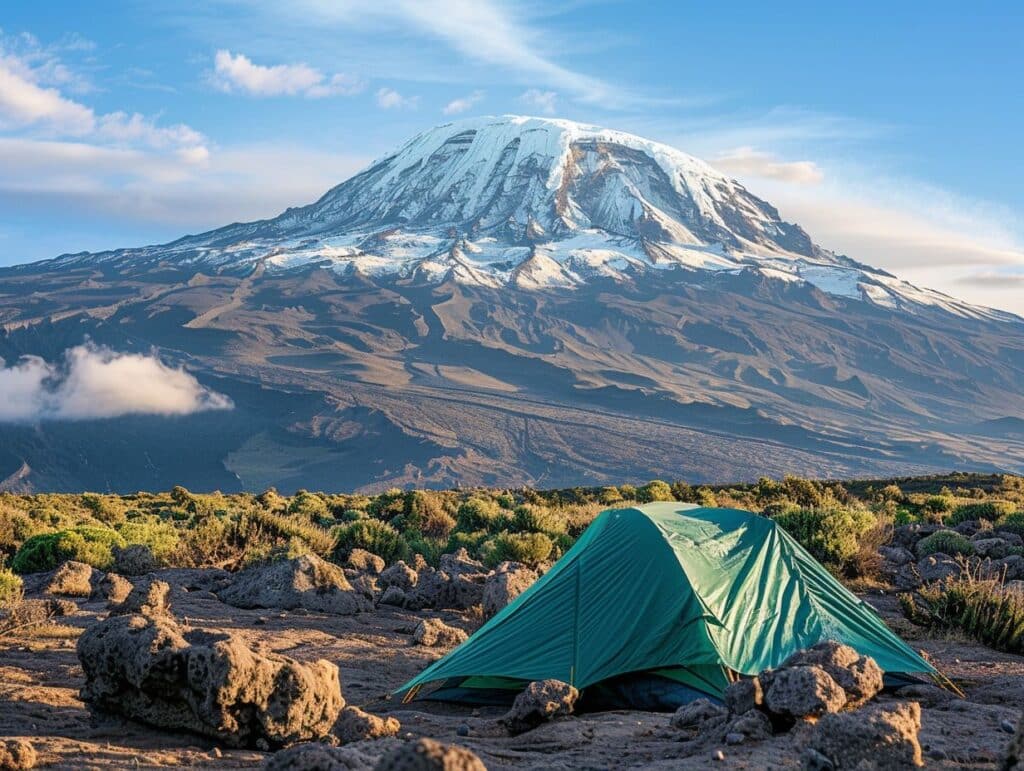
Sleeping on Mount Kilimanjaro is a crucial yet often overlooked aspect of the climb. Properly preparing with the right gear is essential to stay warm and comfortable during the trek. However, it’s important to remember that sleep quality may not always be perfect, as high altitudes can impact your rest. More on this in just a moment.
Getting sufficient rest during your Kilimanjaro climb is crucial for a safe, enjoyable, and successful adventure.
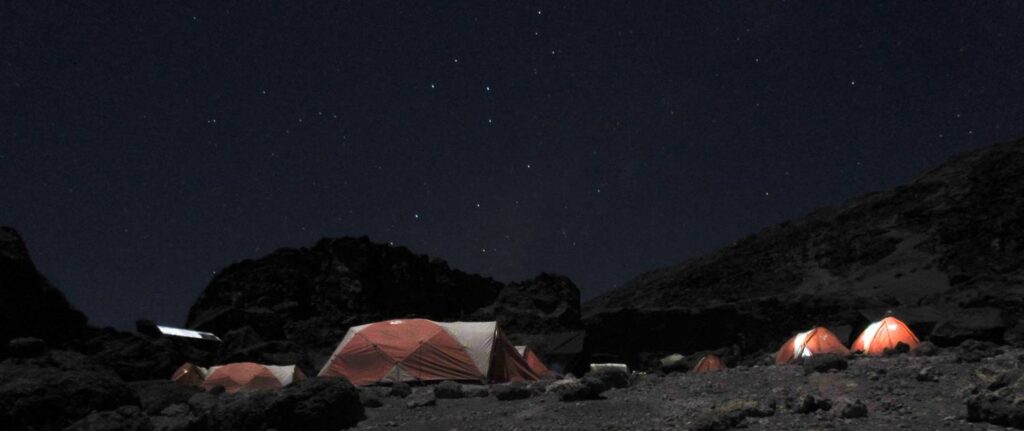
When climbing Mount Kilimanjaro, you’ll sleep in one of two accommodations: mountain huts or tents.
Most climbers stay in tented camps, as hut accommodations are only available on the Marangu route. Fortunately, porters carry and set up all the camping equipment, allowing you to focus on the trek.
Camping is the standard for those trekking any of the Kilimanjaro ascent routes besides the Marangu route. Many find camping to be the more enjoyable and adventurous option.
Like many tour operators, we provide high-quality dome tents that comfortably sleep two people, ensuring a comfortable and memorable camping experience on the mountain.
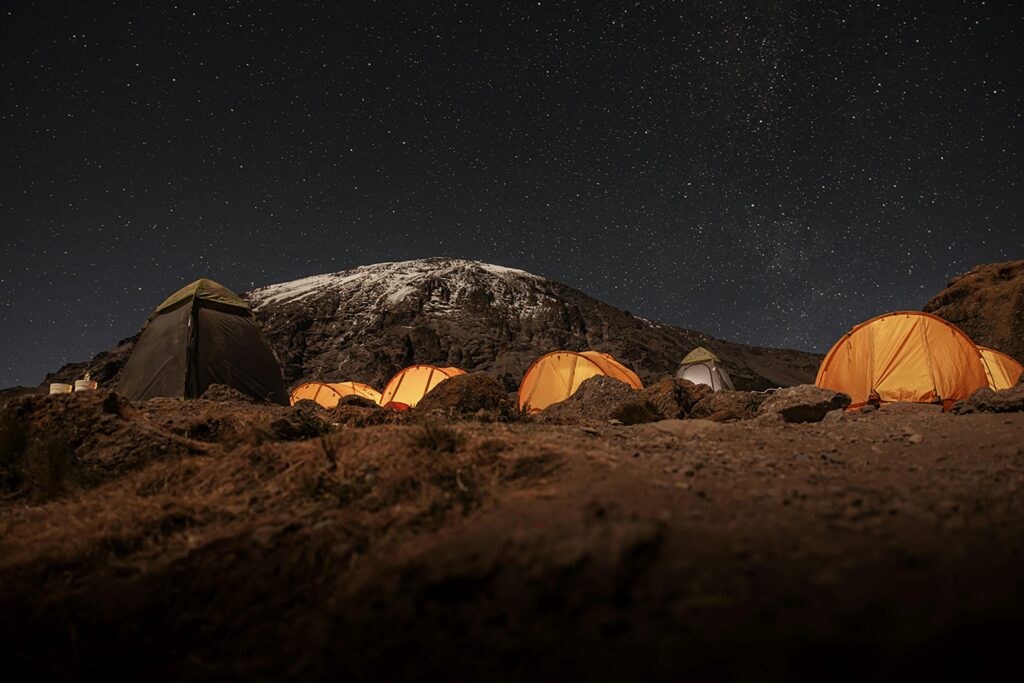
The huts in Kilimanjaro National Park are wooden A-frame structures equipped with beds and mattresses. However, you’ll need to bring your own sleeping bag and pillow for added comfort. These spacious huts accommodate multiple climbers, so be prepared to share the space with others during your stay.
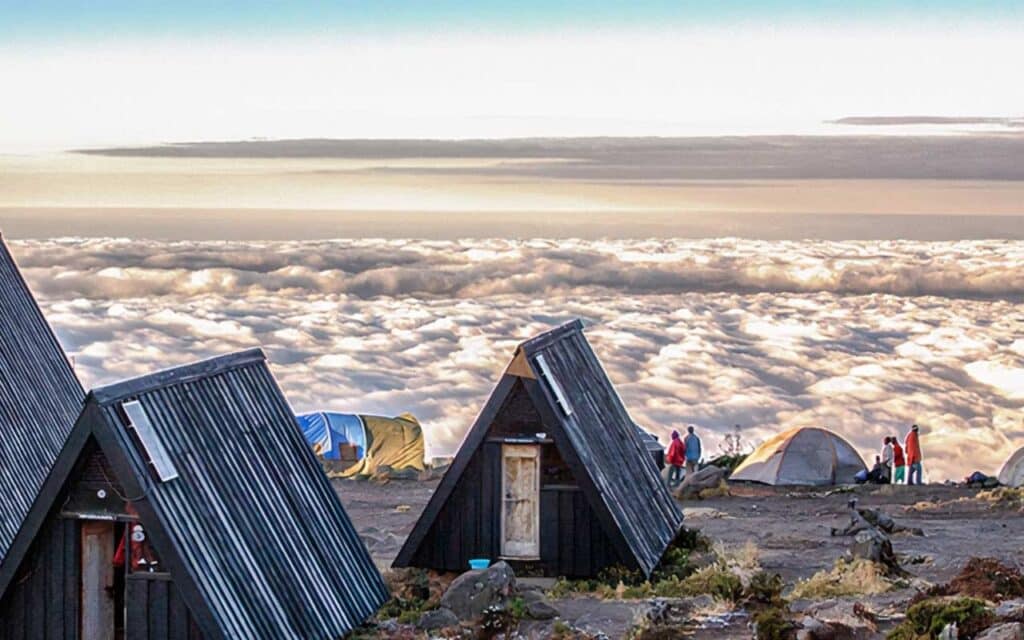
The huts along the Marangu route were constructed because this was the original path up Kilimanjaro. Often referred to as the “Coca-Cola Route,” this trail offers a few amenities, such as the chance to purchase a Coke at specific overnight stops.
As a result, it’s a popular choice among climbers, though it can get quite crowded at times due to its accessibility and the added comfort of hut accommodations.
Here are five essential items every Kilimanjaro climber needs. Let’s begin with the most crucial night-time necessity: a reliable sleeping bag.
Bringing the right sleeping bag to Kilimanjaro is vital. A lightweight or insufficiently insulated bag will not be enough on Africa’s tallest mountain, where the summit’s arctic climate can be brutally cold.
Every trekker needs a four-season sleeping bag designed for extreme conditions to stay warm and comfortable, particularly during the chilly nights at higher altitudes.
We provide a four-season sleeping bag to keep you warm and comfortable during the chilly nights on Kilimanjaro.
Many tour operators expect you to bring your sleeping bag for a Kilimanjaro climb, which is fine—unless you don’t have one or it’s not warm enough. High-quality four-season sleeping bags can be expensive, and not everyone wants to invest in one for a single trip.
We provide a four-season sleeping bag at no extra cost to make things easier. Our North Face sleeping bags are designed to keep you warm, even in the icy conditions near the summit.
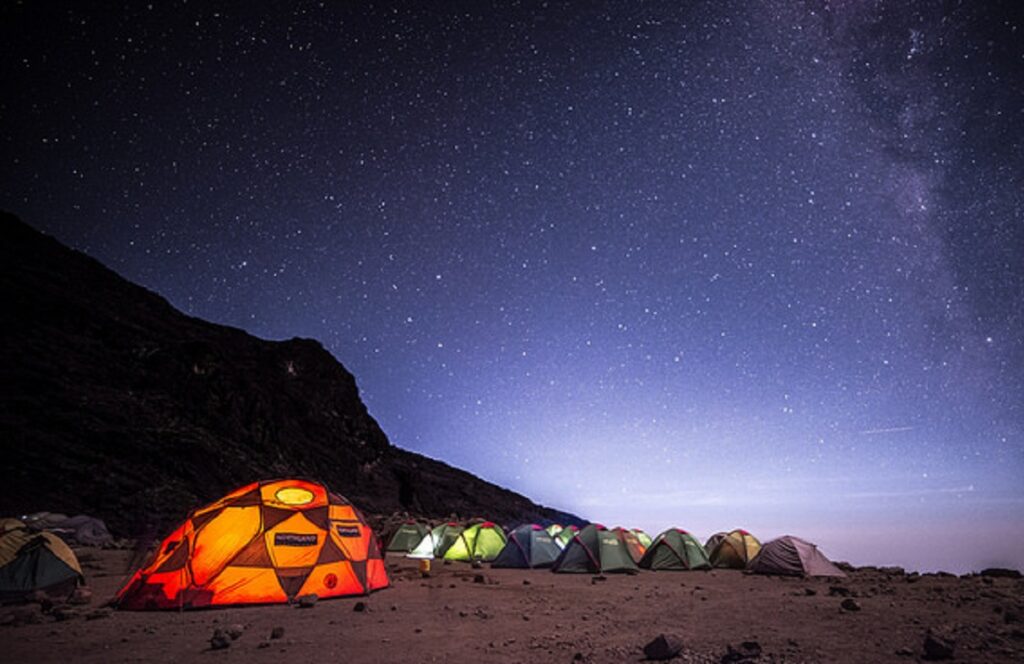
If you don’t have a sleeping bag, your tour operator can provide one, saving you the hassle of carrying a bulky item that would take up valuable luggage space and weight.
Additionally, we supply our climbers with clean sleeping bag liners, which are laundered after every climb. Of course, you’re welcome to bring your own liner if you prefer, for added comfort and hygiene during your trek.
A sleeping mat is essential for trekkers camping on Kilimanjaro, providing an extra layer of insulation and cushioning between you and the cold, hard ground.
Choose a thick, insulated mat for optimal comfort and warmth. It’s vital to stay warm and comfortable, especially during the colder nights at higher altitudes.
Fortunately, you won’t need to carry it yourself—your mountain crew’s porters handle all the gear, including your sleeping mat.
At Great Image Expedition, we provide sleeping mats to our clients at no additional cost, so that’s one less thing for you to worry about! 😊
A thermal sleeping mat is essential for staying warm and comfortable on Kilimanjaro nights.
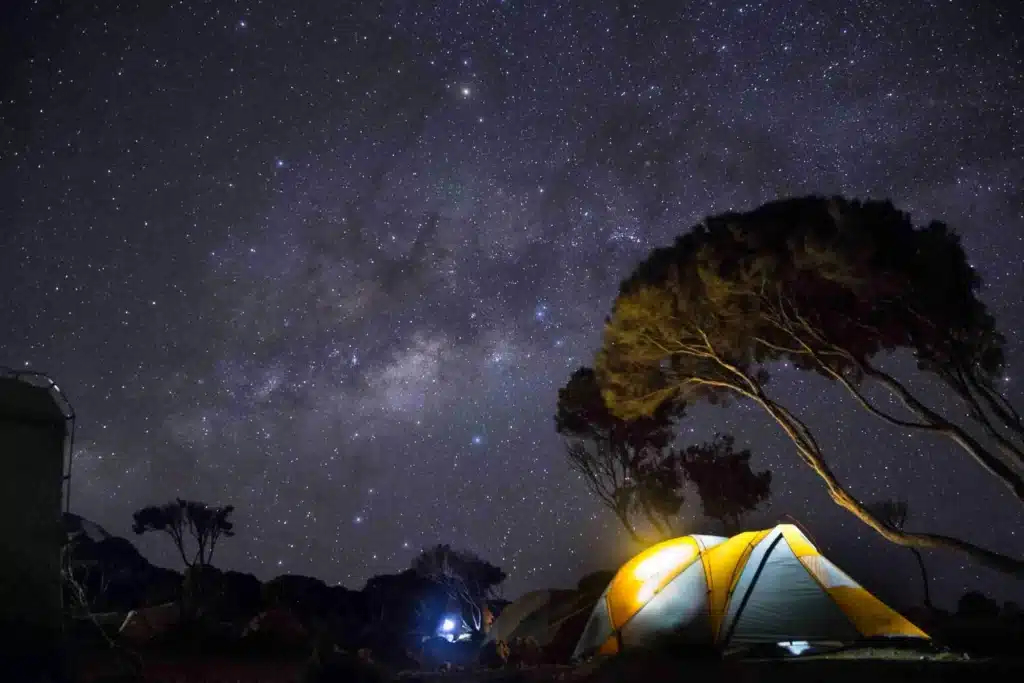
The only trekkers who don’t need to bring sleeping mats are those on the Marangu route, as the mountain huts have mattresses.
Most climbers need a pillow for comfort, and Kilimanjaro is no exception. While you can bring your own, make sure it’s compact enough to fit in your duffel bag to save space and weight.
Packing a pillowcase and stuffing your winter jacket inside it each night is a clever trick. This creates a cosy, makeshift pillow, ensuring a more restful sleep on the mountain.
Packaging your winter jacket into a pillowcase doubles as a soft pillow for the night, saving you valuable space in your duffel bag.
When preparing for Mount Kilimanjaro Trekking, a winter jacket is a must-have!
You’ll especially need one at night, as temperatures on the mountain can drop well below freezing. Remember, you’re climbing to nearly 6,000 meters above sea level, where the climate shifts to alpine desert and then to arctic conditions.
Down jackets offer exceptional warmth in these subzero temperatures. Regardless of the insulation material, ensure that the coat you choose—whether you buy, rent, or borrow—is a proper winter jacket designed for extreme conditions.
Winter jackets can be expensive, so if you don’t own one, we offer rentals at Great Image Expedition for a flat fee of US$40. Our jackets come in a vibrant red and black design, as shown in the image below.
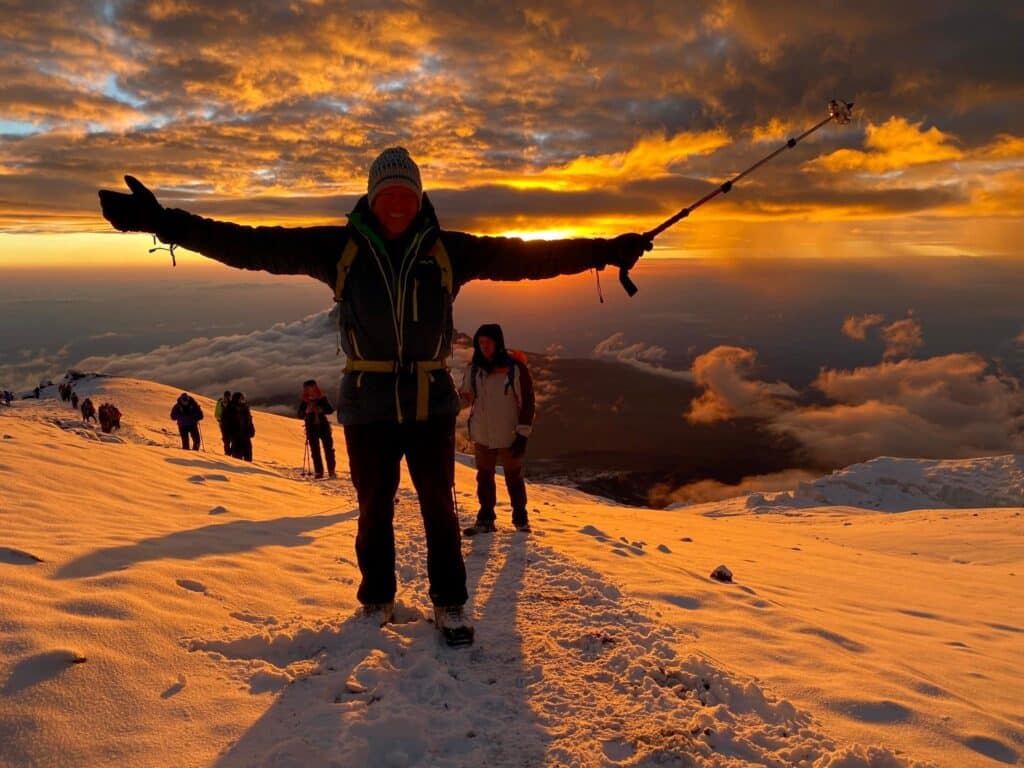
You’ll also need other essential warm items, such as a beanie and thermal gloves, for the nights on Kilimanjaro. Our comprehensive Kilimanjaro packing list details these items.
We offer down jackets designed to handle the harsh conditions in Kilimanjaro, which are available for rent at a flat fee of US$40.
A head torch (flashlight) is essential for navigating camp at night on Kilimanjaro.
While the mess tent is equipped with lamps for the evening, you’ll need your light for tasks like moving around your tent or visiting the toilet tent. It’s an indispensable piece of gear for night-time mobility on the mountain.
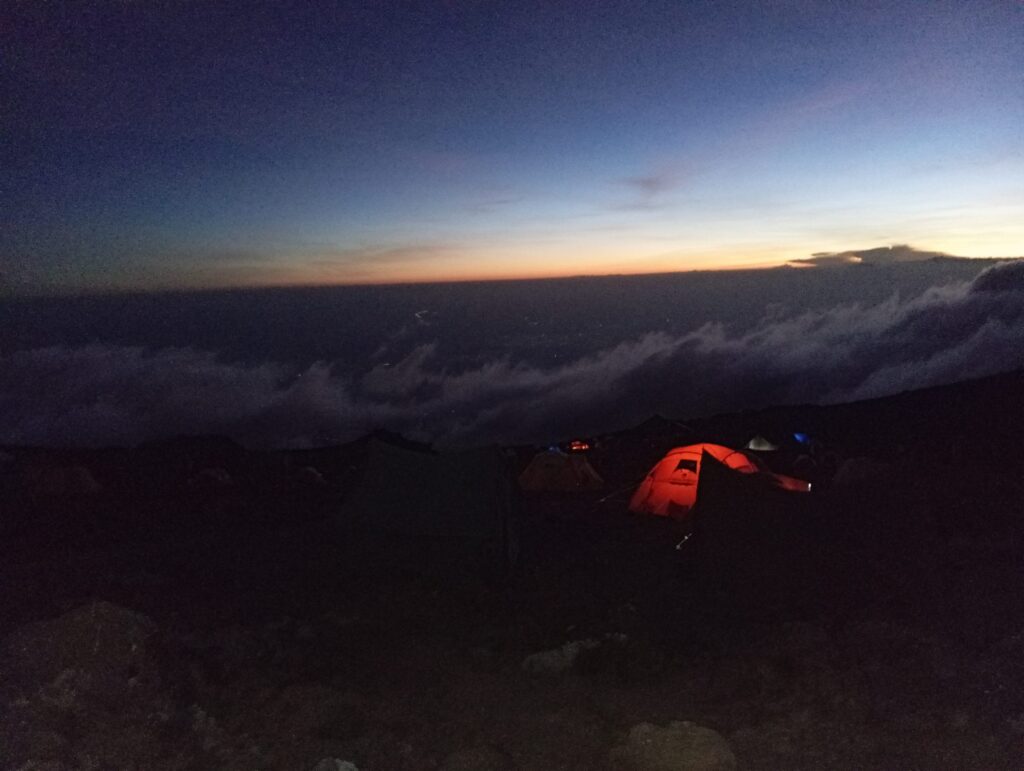
Before leaving home, test your head torch to ensure it’s working correctly. We recommend replacing the batteries with fresh ones and packing some spares. Additionally, you might want to bring a small standing lamp inside your tent.
Bring a headlamp on your trek to avoid stumbling around camp and tripping over guy ropes.
Sleeping at high altitudes can be notoriously tricky. If you haven’t heard this before, let us explain: don’t expect to sleep soundly during your climb, even after all the physical exertion and fresh mountain air.
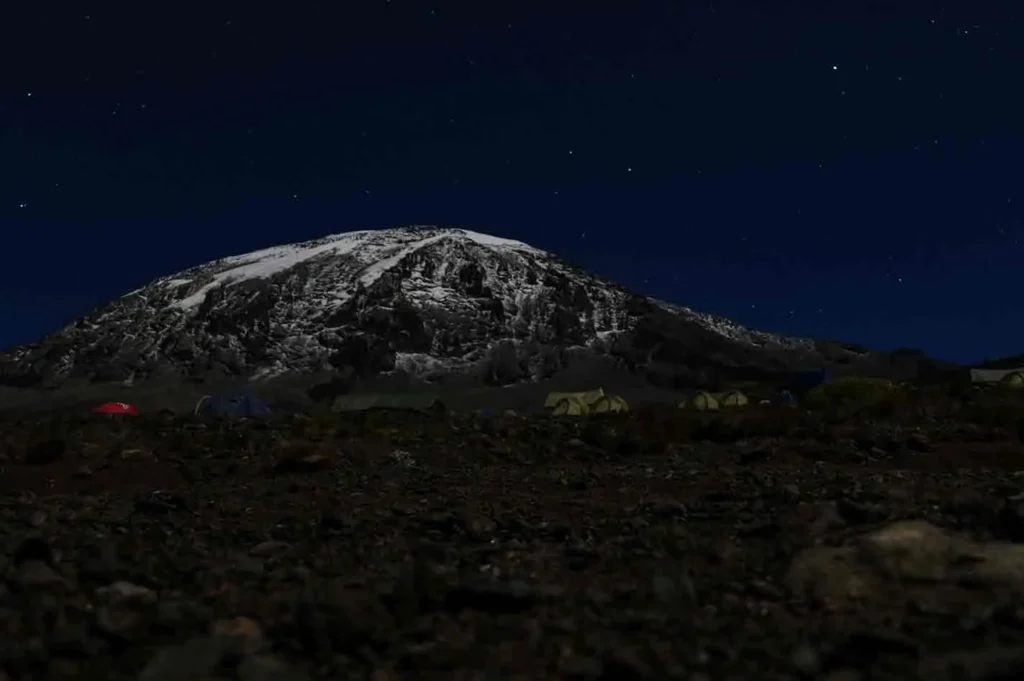
At high altitudes, the reduced oxygen levels can make sleep more difficult, affecting your breathing and resulting in poorer sleep quality. While this may lead to fatigue the next day, it’s completely normal and part of the experience. It’s just another challenge that requires determination to overcome as you aim for the summit of Kilimanjaro!
When you reach higher altitudes on the mountain, falling asleep can become more challenging. Some climbers experience fitful sleep, while others report having vivid dreams. This is all part of the Kilimanjaro adventure!
Lack of sleep is a common challenge in high-altitude trekking.
In one sense, you accept that your sleep will likely be impacted during your Kilimanjaro climb. Understanding that most people find sleeping on Kilimanjaro difficult might eliminate a little of the potential stress, allowing you to mentally prepare for it.
You should also do what you can to help yourself get the best sleep possible. Focus on creating a comfortable sleep environment, managing your energy during the day, and staying hydrated to improve your chances of a restful night.
Getting a good night’s sleep on Kilimanjaro can be challenging, especially at high altitudes. Here are some helpful tips to improve your chances of getting restful sleep:
After a long day, your sleeping bag will have been compressed during transport, clumping in the insulation, particularly with down bags. To ensure maximum warmth, shake your sleeping bag before getting inside. This helps redistribute the filling and ensures you stay warm during the night.
A significant amount of body heat is lost through your head, so even if your sleeping bag has a hood, it’s a good idea to wear a soft, comfortable beanie at night. Choose a separate one from your trekking hat to keep it clean and dry. Wool, cashmere, or felt beanies are excellent options for keeping you warm.
Avoid drinking too much right before going to sleep to prevent needing to wake up in the middle of the night. However, staying hydrated throughout the day is important to help avoid altitude sickness. Aim to drink plenty of water during the day, but taper off before bedtime. If you’re still thirsty at night, take small sips.
Also, packing a pee funnel and a sealable jar could be helpful if you need to pee during the night and do not want to venture outside into the cold.
To minimize interruptions, visit the toilet before settling down for the night. Even if you don’t feel an urgent need, it’s a good idea to make a “paranoia pee” to avoid getting up in the middle of the night.
While the nights are generally quiet, there’s always some background noise, especially if you’re among the first to settle in. The porters and cooks also wake up early to prepare breakfast. Bring a pair of earplugs to block out any unwanted sounds—whether from fellow climbers or the early morning bustle. They’re instrumental if you’re a light sleeper or prone to being disturbed by snorers.

Nighttime on Kilimanjaro is an unforgettable experience. Imagine the sight of tents glowing from within, casting a warm light against the encroaching darkness. For a few days, you’re part of a minor, adventurous community gathered on the slopes of this vast and imposing mountain.
At camps like Karanga Camp and Shira 2 Camp, you’ll be treated to some breathtaking sunsets. We highly recommend stepping outside to witness these magical moments. The sky is painted with stunning colours, and rolling clouds shift in hues as the sun dips below the horizon. It’s a well-earned reward after a day of trekking!
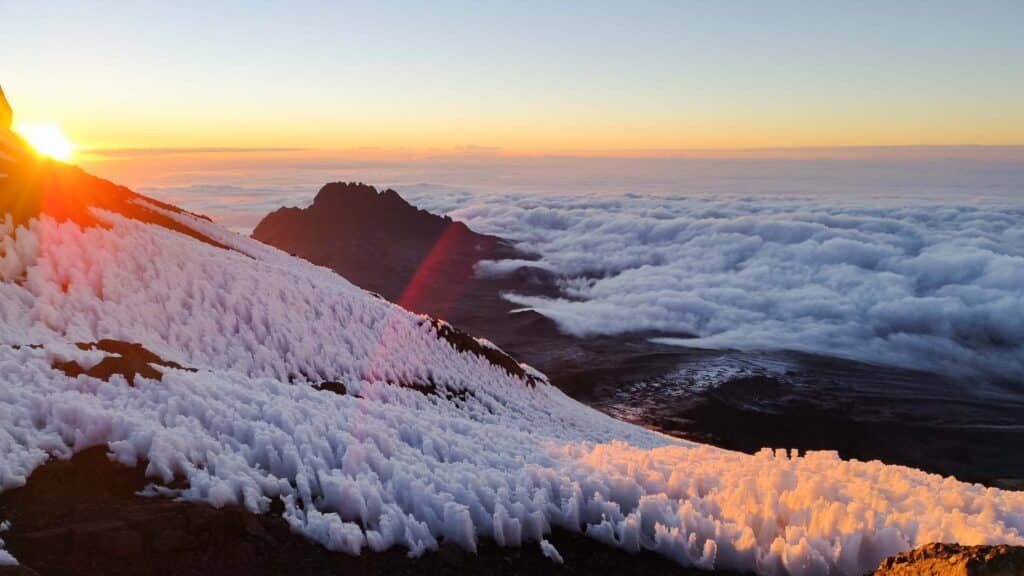
One of the most awe-inspiring experiences while climbing Kilimanjaro is gazing at the star-filled night sky. The lack of light pollution at higher altitudes offers an apparent view of the heavens. The Milky Way stretches across the sky, and with some luck, you might spot the Southern Cross, adding to the magic of the mountain’s serene, starlit nights.
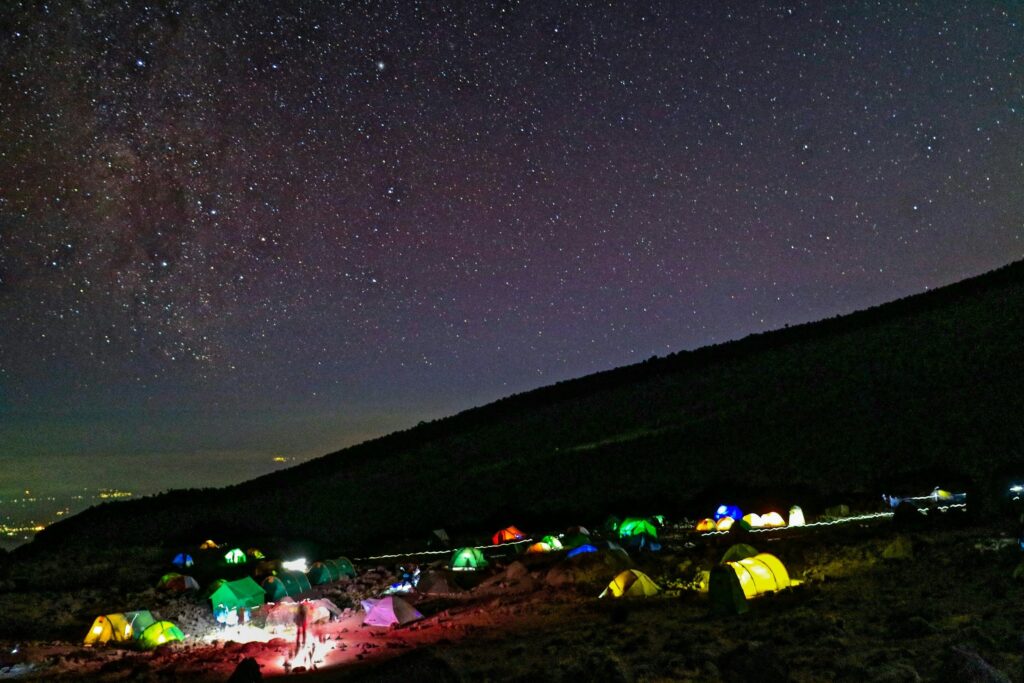
The sunrises on Kilimanjaro are genuinely spectacular. The views become more open and unobstructed as you ascend through the rainforest zone and into the moorland, alpine desert, and, finally, the arctic zones. These higher altitude areas have few or no trees, allowing you to take panoramic views of the mountain’s plains. You’ll often find yourself looking down on the cloud bank covering the lower slopes. When the sun rises above the clouds, it feels like you’re on top of the world! We highly recommend taking a moment each morning—whether stepping out of your tent or just poking your head out—to enjoy the breathtaking beauty of the sunrise.
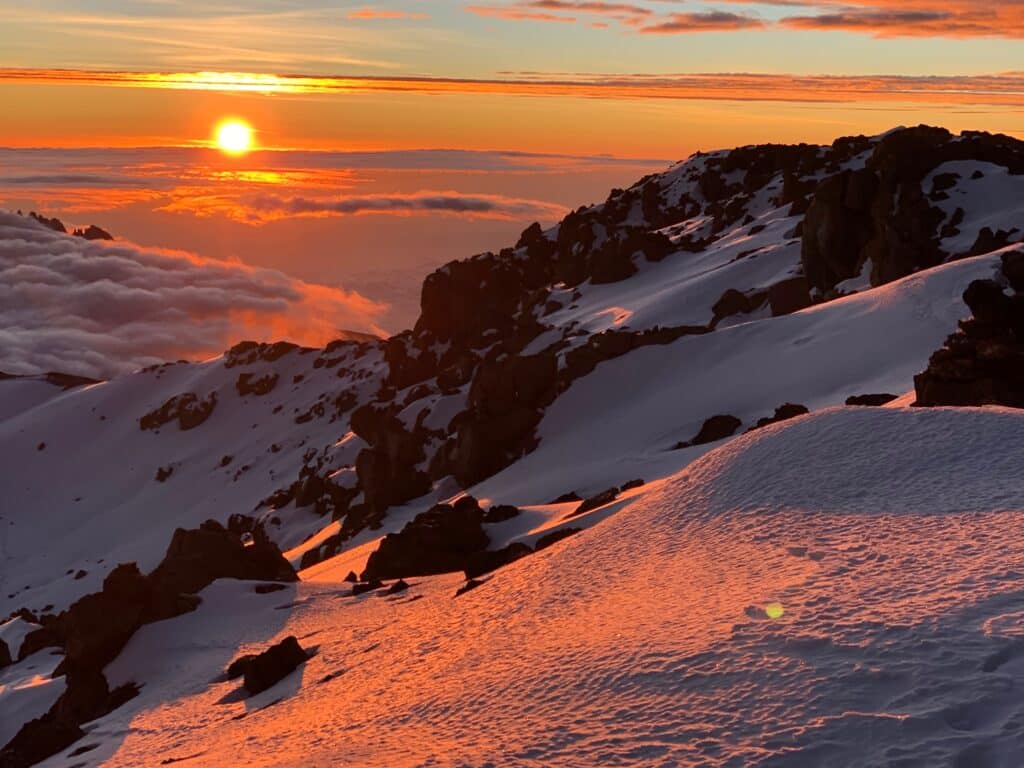
Did you know that no matter which of the seven routes you take to climb Kilimanjaro, your summit attempt begins at midnight?
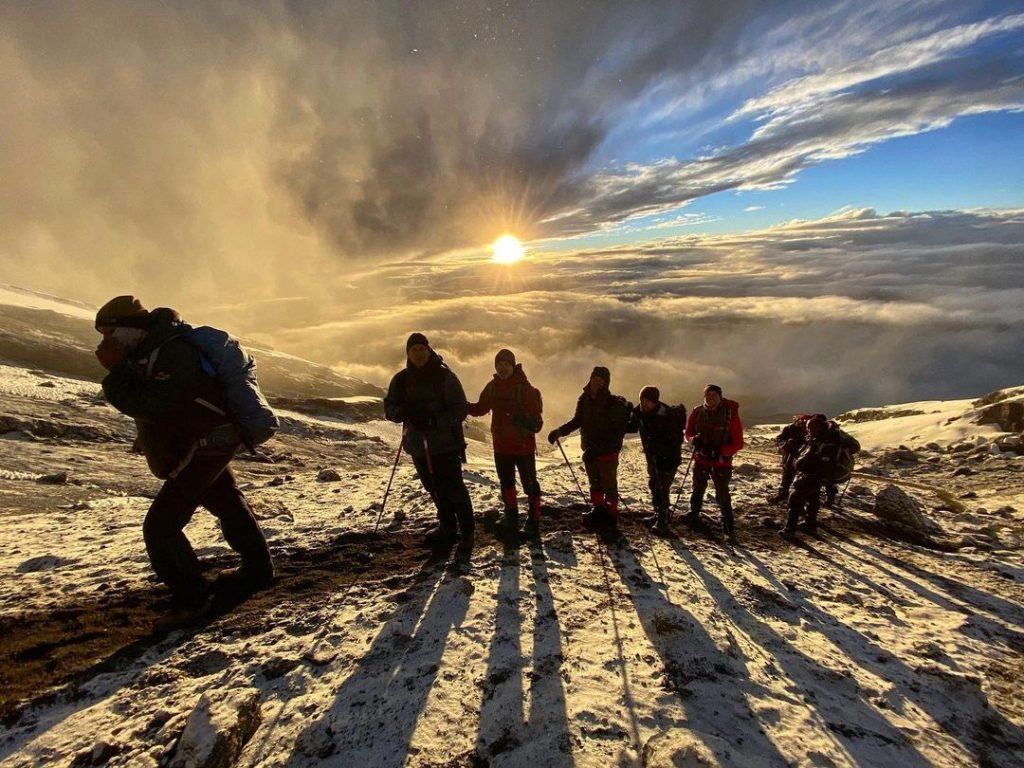
You begin your hike to Uhuru Peak at an early hour because summit day is an incredibly long day — typically lasting at least 13 hours. The term “summit day” can be a bit misleading, though, as much of the day is spent descending the mountain. After reaching the summit just after sunrise, you’ll spend the rest of the day trekking back down a significant portion of the mountain.
Summit day is the ultimate challenge, the “Big Push.” It’s the most physically and mentally demanding part of the entire climb, testing your endurance and determination to the fullest.
Nothing beats a Kilimanjaro full-moon climb in our opinion.
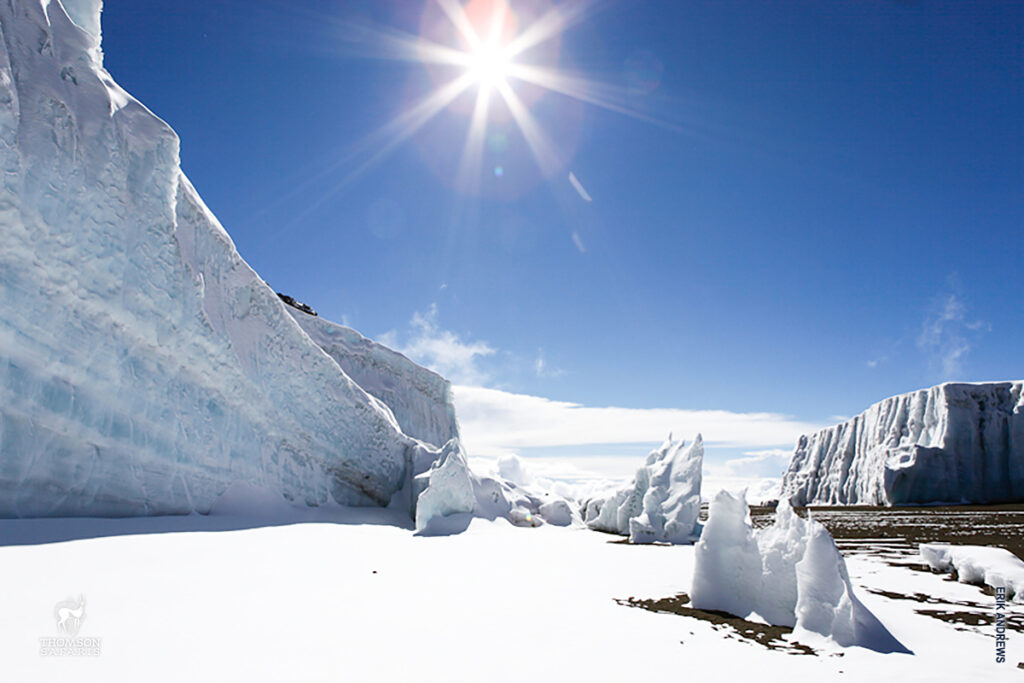
Starting your summit day at midnight means you’ll usually be trekking in the dark, guided only by the beam of your headlamp. However, a full-moon climb offers a magical experience, as the bright moonlight lights your path the entire way, eliminating the need for artificial light.
Hiking under the full moon makes the challenging ascent a bit easier and adds a layer of beauty to the journey. The moon casts a glow on the peak you’re heading toward, highlights the glaciers, and allows you to see the vast stretches of the mountain you’ve already conquered below you. We highly recommend a full-moon climb—it’s a truly unforgettable experience!
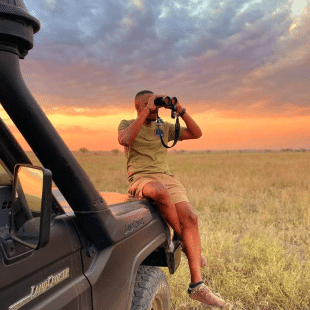
Head of written content